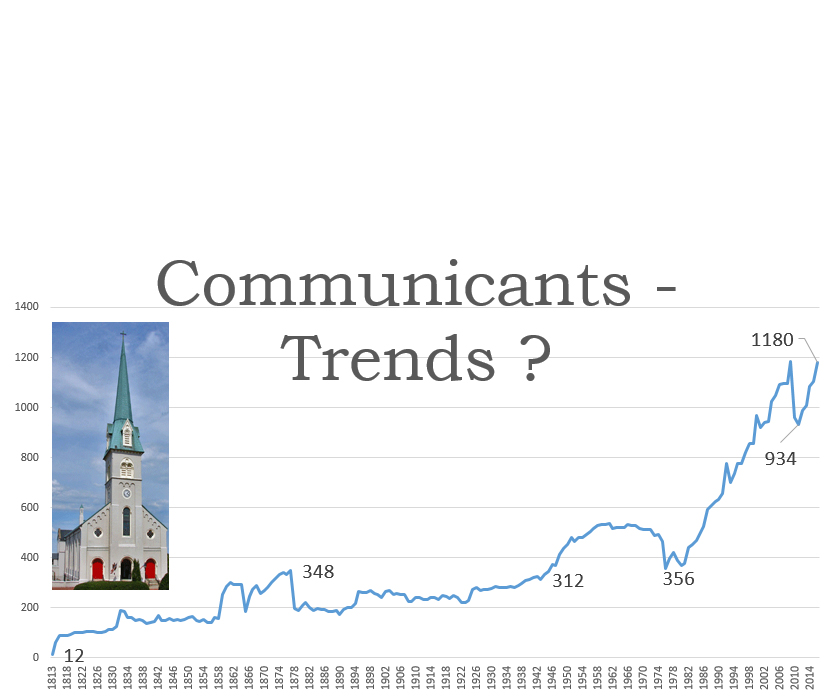A review of communicants is designed to try to understand the growth (or lack of) in different periods in St. George’s history. First how is a communicant different from a baptized member? We look to the Canons:
Canon 1.17.1
Sec. 1 (a) All persons who have received the Sacrament of Holy Baptism with water in the Name of the Father, and of the Son, and of the Holy Spirit, whether in this Church or in another Christian Church, and whose Baptisms have been duly recorded in this Church, are members thereof.
Canon 1.17.2–4
Sec. 2 (a) All members of this Church who have received Holy Communion in this Church at least three times during the preceding year are to be considered communicants of this Church.
(b) For the purposes of statistical consistency throughout the Church, communicants sixteen years of age and over are to be considered adult communicants.
Sec. 3. All communicants of this Church who for the previous year have been faithful in corporate worship, unless for good cause prevented, and have been faithful in working, praying, and giving for the spread of the Kingdom of God, are to be considered communicants in good standing
A communicant is a subset of baptized member who received communion 3 times a year. Communion has been designated as a principal service. Studying communicants is a better measure of growth because these people are actually participating in services during the year rather than only being a name in the baptism roles.
What affects growth? Over St. George’s history some factors include the minister as well as changes in the Episcopal church dealing with the prayer book or social issues (LGBT). Interim periods tend to reduce growth or reduce the number of communicants. There are also internal issues to consider at different time periods.
One weakness in using communicant numbers is a problem in determining who the communicants are. While membership is well documented, the number of communicants is not documented by any records except what is there in the parish register. Can leadership really determine who came to communion three times a year ?
Over the years scholars has attempted to determine what affects growth in the Episcopal church.
Davis L. Holmes in A Brief History of the Episcopal Church suggested that most Episcopal churches were unconcerned with growth for many years. A 1990 study of an Episcopal diocese that grew faster than the population identified the following contributors to growth:
- Widespread use of the diocesan camp
- Extensive investment in ministries to high school and college students through education in the meaning of stewardship,
voluntary financial support to the Diocese - considerable commitment in outreach and poverty relief
- close relations with an overseas diocese
- support for communicants who volunteer for overseas service
- Team ministries to prisoners
- Diverse group of clergy
For St. George’s it could be linked to education as shown above, outreach and mission programs as well as newcomer and welcome ministries.
Diana Butler Bass has studied church growth for years. She researched Ten Signposts of Renewal from Christianity for the Rest of Us” (2007).
Bass researched 50 congregations for study. The 50 congregations were chosen “in which new things appeared to be happening, and where people were growing deeper and experiencing a new sense of identity by intentionally engaging Christian practices.” 10 congregations served as “in-depth” sites where researchers devoted several weeks or months to the churches. The sizes of the congregations ranged from 35 to 2,500 members and they were part of multiple denominations.
Ten Signpost of renewal (with page numbers from her book)
- Hospitality
“Hospitality is the ‘creation of free space’ where strangers become friends. ‘Hospitality is not to change people, but to offer them space where change can take place’” (79).
- Discernment
Discernment is “a genuine sensing of truth and beauty through which we know God and know God’s will….But Christian tradition points toward…discernment as a practice that can be developed through participation in reflection, questions, prayer, and community” (91).
The third way: Asking ‘God-questions’ instead of ‘I-questions.’ “God-questions shift our focus from what we do to what God is doing, by helping us understand where we fit in the larger economy of God’s hope for the world” (94).
- Healing
“Harmony is a kind of healing or making whole, the creation of what is disordered into what is ordered. In short, harmony is a kind of healing or making whole, the creation of what is disordered into what is ordered” “God’s salvation is a process of healing whereby they are transformed—and, in turn, they open themselves to transforming the world” (106).
- Contemplation
Saint Bernard of Clairvaux: “‘Continual silence, and removal from the noise of the things in this world and forgetfulness of them, lifts the heart and asks us to think of the things of heave and sets our heart upon them’” (117).
- Testimony
“At most of the congregations I visited, I heard people speak of faith—offering their testimonies to the power of God in changing their lives and their communities” (133).
“Our stories no longer tell tales of spiritual acquiescence and conformity. Rather, they tell of finding meaning, finding unique selves, and finding God in a confusing and chaotic world” (138).
“Testimony is not about God fixing people. Rather, it speaks of God making wholeness out of human woundedness, human incompleteness” (141).
- Diversity
‘the loss in homogeneity leads to a richer diversity’ [that] is a source of ‘complex wisdom’” (145). “Unlike evangelical churches – where doctrinal uniformity is considered nonnegotiable—theological diversity shapes the daily life of most mainline churches” (146).
Cherishing diversity of every kind: political, theological, cultural, and racial (148).
- Justice
“Doing justice is much more than supporting a particular party and its policy agenda. Doing justice goes beyond fixing unfair and oppressive structures. Doing justice means engaging the powers – transforming the ‘inner spirit’ of all systems of injustice, violence and exclusion” (161).
“Throughout my journey with emerging mainline congregations, I encountered people doing justice that involved hands-on service, linking social concerns and spirituality in local mission and activism” (164).
- Worship
Alternative worship’s influence on traditional worship: Scottsdale Congregational “takes the material of everyday life – art, music, film, and reflection – and assumes that it is the entryway to the sacred. Combining elements of jazz, performance art, film clips and video, multimedia reflection, live-camera feed, testimony, readings, silence, contemplative prayer, and journaling, they christened this service The Studio” Eventually, they moved elements of that alternative service to the traditional service: “…instead of jettisoning traditional worship, [they] applied the principles of experiential worship from The Studio to the other service. (174).
“In the congregations in my study, mainline worship had moved eighteen inches: from the head to the heart.”
“Worship is much more than something Christians attend on Sunday morning – it is something pilgrims make together” (178).
- Reflection
“At its core, theological reflection is a way of seeing the world, of being able to imagine life in a relationship to God’s story, of linking the intellectual content of faith to its everyday practice” (187).
“At Redeemer [Church], teaching and Bible study are not concerned with dogma and doctrinal facts; rather, they immerse themselves in the biblical stories, attempting to connect their lives with the text’s ancient wisdom” (188).
- Beauty
“In every congregation I visited, there was a growing emphasis on beauty, on knowing God through art, music, and drama, on engaging more than just the mind” (208).
“Some people refer to this turn of intellectual events as ‘postmodern,’ a shift away from Enlightenment reason toward more experiential forms of knowing” (209).
“Christianity is changing – from being the Truth of rational speculation to being an exploration of the exquisite truthfulness of beauty” (210)
St George’s Communicants
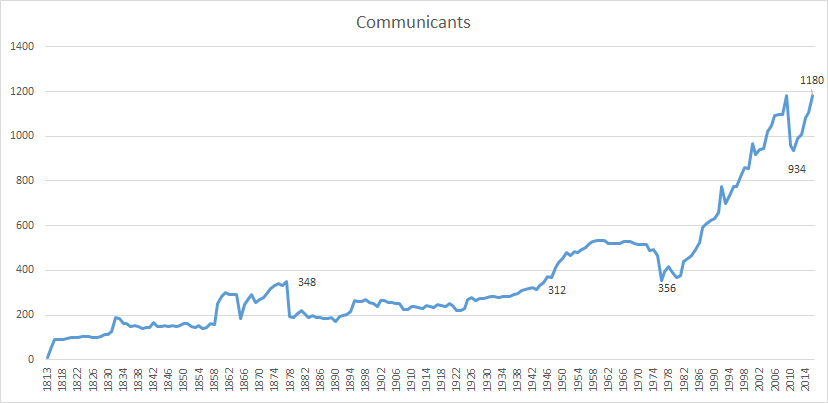
8 periods of Communicant trends can be identified
1. McGuire/Randolph Years 1813-1862
Growth accelerated during the decade from 1823 to 1832 which corresponded to the 2nd Great Awakening. It changed the composition of denominations with the shift away from Congregationalists and Anglicans toward the Methodists and Baptists. McGuire tapped into this movement with his low church evangelical style .
Communicants rose from 106 in 1823 to 188 in 1832. The growth was more of a spike from 125 to 188 during 1831- 1832.
Revivals characterized the Awakening and in the Methodist church, the camp meeting. St. George’s must have had its own revivals. McGuire wrote in the Convention Journal in 1823 -“Though the subjects of revivals in other parts of the Lord’s vineyard may have been more numerous, there are few instances in which a revival has been characterized by more genuine or decided cases of conversion.”
McGuire noted the early years of the increases. He wrote in 1826 “The church is in a prosperous and flourishing state. The numerical increase of the congregation has been considerable in the past year. The services in the sanctuary have been more fully attended, especially in the afternoon, than at any previous period of the rector’s ministry among these people.”
In 1832, he reported “Bishop Meade confirmed seventy-five in September last – most than fifty of whom united for the first time in commemorating the death of our savior. Since that time about thirty more have been admitted to the holy communion, making the whole amount of increase since the last Convention about eighty-five members.” This is an amazing number which is exceed any other month in our history.
See chart below
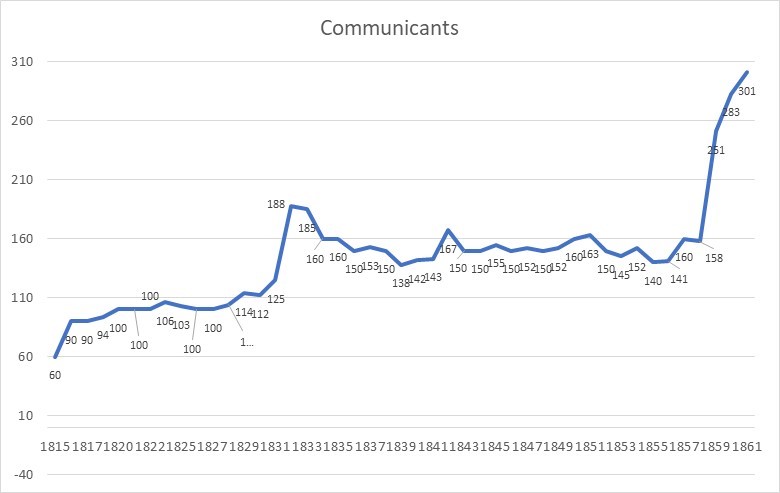
The growth faded for the next decade from 1832 to 1841. In particular, the growth of the Presbyterian church took members away. In 1839, he blamed death and removals which may mean that people transferred to other denominations or simply left the church. “The loss of members has been considerable by deaths and removals – additions few, and those, in part, from other parishes.
However, even in 1837 he said that while the church wasn’t growing attendance at services was. “During the past year, no very marked indications of religious sensibility have appeared in this congregation. There is ever thing however to encourage, in a full and punctual attendance on the services of the sanctuary. We are unable to accommodate many in their applications for pews.”
Growth double again from the time of McGuire’s death in 1858 to the beginning of the Civil War. Communicants rose in 1858 from 158 to 301 by 1861. He noted the changes in his last year.
“A remarkable religious interest made its appearance amongst us in the month of March and occasions of divine worship and preaching the word being multiplied in answer to the growing demand on the part of awakened souls. These services were continued with still increasing interest, kept up and kindly applied by the labors of brethren in the ministry from various parishes, during the sickness of the Rector, lasting several weeks. The word was quick and powerful as dispensed by earnest and zealous preachers, and the hardest hearts did melt and many cries were heard, “Lord what wilt thou have me to do?” About 80 persons have been the subjects of the blessed work, and whilst that number, or thereabouts were confirmed by the Bishop on the 12th, many more remain to be gathered in pastoral care and diligence in the fold of Christ.”
In 1858, there were 93 confirmations!Did the rising tensions in the country lead people back to church?Were the increases after McGuire’s death the results of Rev. Alfred Randolph or the results of McGuire’s last work?
2. Reconstruction 1865-1878
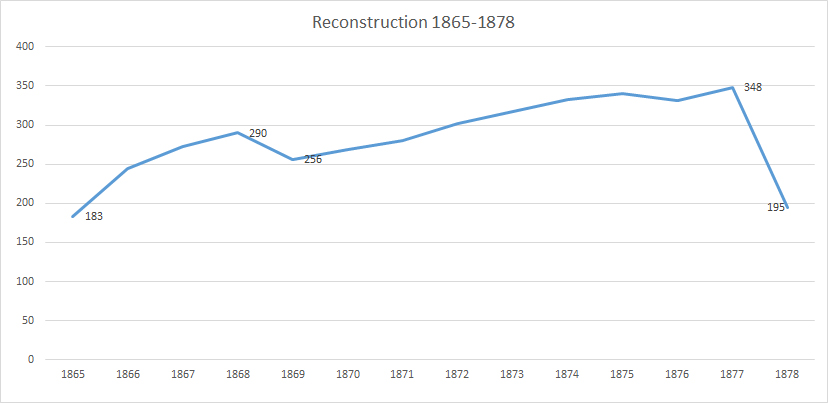
The church reopened in late 1864 after the war though the effects were being felt in 1865 as the church had to confront the damage. During the next five years in the midst of recovery, communicants grew from 183 to 269 as the church rebuilt its structure. The 1870’s were a fertile ground as the church bought a new organ and communicants rose from 269 to 348 or by 29%. The main blow came in 1877 when the split which became Trinity occurred and communicants plummeted from 348 to 195.
3. Interim 1878-1945

After the split, the number of communicants rose from 195 to 265 slightly larger than the earlier period at 35% but which took a larger period, from 1878-1895.
There was contention in William Smith’s period 1897-1905 over money and control with the Vestry which may have reflected in a decrease in 265 to 255. The pew system was also increasingly being called into question
There was moderate growth in the 1930’s. From 1930-1946, the number of communicants rose from 278 to 371 or 33%. A more vibrant music program and Elsie Lewis’ leadership in the Sunday school may have caused some of the growth. Also the country was in depression which may have accelerated church going. By 1946, the church finally recovered to equal the number of communicants present at the time of the split with Trinity.
Overall in the interim period the church grew from 208 in 1880 to 346 in 1945 at a rate of 66%. This was less than the growth of poplulation for Fredericksburg which doubled from 5,010 in 1880 to 10,066 in 1940.
4. Early Faulkner year 1946-1961
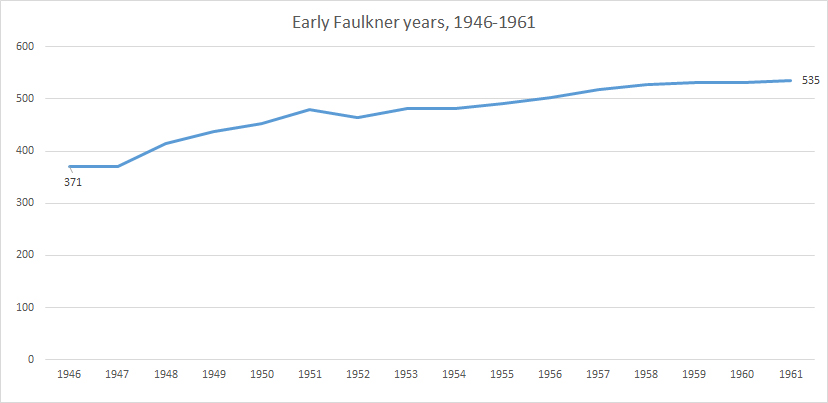
The early Faulkner period from 1946, when he came to Fredericksburg in 1946 to 1961 or 15 year later showed an increase from 371 to 535 or 44%. The number of communicants generally increased each year. These years may have been helped by physical changes inside the church as well the new McGuire Hall as well as continual growth in Sunday schools. This growth was slightly higher than that of Fredericksburg which rose from 10,066 to 13,639.
5. Downturn 1966-1976

The downturn is symptomatic of other mainline churches. Membership in the Episcopal church peaked in the mid-1960’s as did most mainline churches. In 1966 it was 3.4 million and declined in the 1970’s and stabilized below 3 million in the 1980’s.
Communicants for the 10 years from 1966 declined from 531 to 356. Most of the decrease occurred from 1975 to 1976 when the drop was from 465 to 356 which erased the growth of the Faulkner era. 1976 was when Faulkner retired which could explain some of the decline. After 30 years, many members could not remember another priest.
6. Sydnor Years 1976-2003
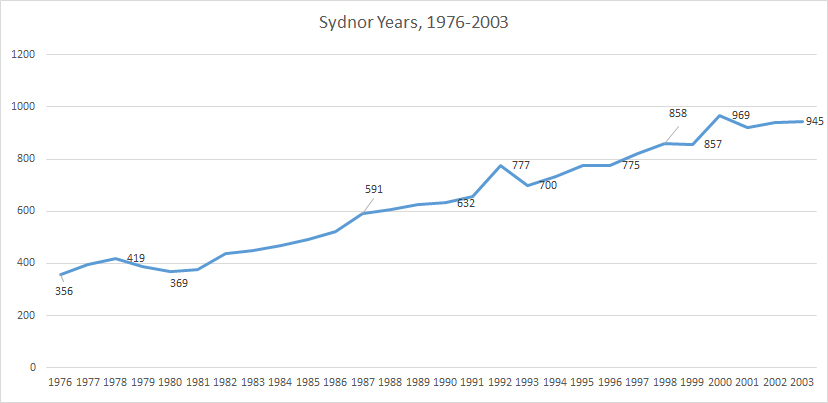
This was a period of rapid from growth from 356 in 1976 to 945 in 2003, a 160% increase. This exceeded the rise of Fredericksburg from 14,450 in 1970 to 21,660 or 50% increase. To be fair, St. George’s was also drawing on the counties as subdivisions came unto their own from the 1980’s for the next 20 years.
Despite the trend in growth there were periods that showed declines. In 1978, there were 419 communicants which had declined to 378 in 1981. Affecting this time period may have been 3 Episcopal national trends – the ordination of women in 1976, the new prayer book in 1979 and increasing emphasis on rights of homosexuals. The prayer book divided St. George’s and affected the renovation of the church during the late 1970’s and early 1980’s.
The numbers recovered with communicants increasing from 369 to 632 or by over 70%. Outreach ministries with Hope House and the Shelter and the increasing leadership by lay people may have helped the numbers.
Charles Sydnor ran into problems in the 1990’s with financial strains, the scandal and the increasing effort by the Vestry to engage in an Mutual Ministry review and call into question his leadership. This doesn’t affect the communicant numbers as they rose from 632 in 1990 to 969 in 2000, or over 50%.
7. Dannals 2004-2013

The Dannals years show a decline in communicants from 1023 to 1008. In 2010 communicants were reviewed and some cut from the list. This single year shows a reduction from 1184 to 960.
The election of Gene Robinson as bishop coadjutor in 2003 and then diocesan bishop of New Hampshire in March 2004 did have an effect on the rolls thought it is impossible to determine the extent.
The Dannals years restructured services and liturgy that he based on the 2004 Profile. His style, sometimes more brash, was very different from the Sydnor years. All of this may have affected growth of communicants. Still, the church he built during these years became that which the next rector inherited and has persisted.
8. Current 2013-
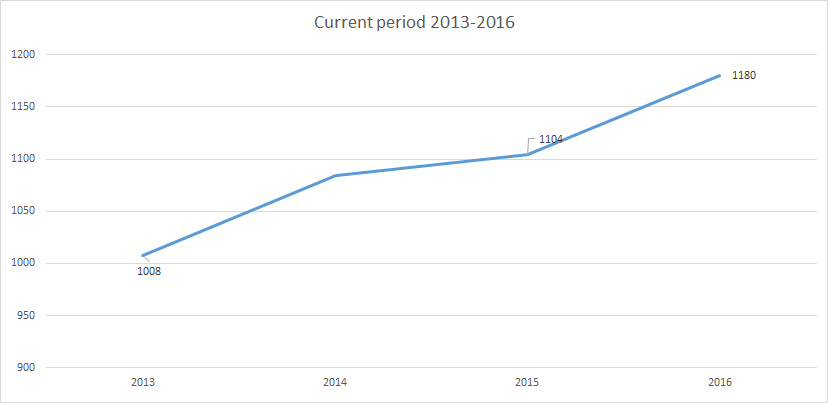
As of the end of 2017, Rev. Joe Hensley (2015) has helped the church recover the number of communicants back to the 2009-2010 revision. He built a sense of community over Jim Dannals structure combining an increasing focus on the “welcome” and small group ministries. His demeanor was much more pleasant and consistent. He also has been determined to understand St. George’s growth and be willing to go outside the church to consider purchasing additional property.
